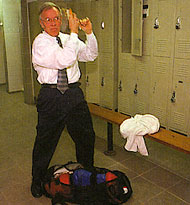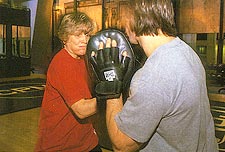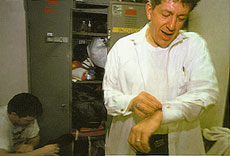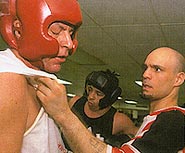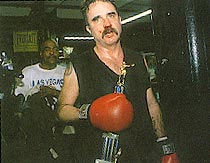THE LONDON TIMES MAGAZINE, August 7, 1999, page 42
wall street fighters
By day they work in a corporate war zone. By night their battleground is the boxing ring. New York's thrill-seeking high-fliers have ditched their gym workouts to become part-time prize fighters--and the craze for white collar boxing is heading this wayAt Gleason's boxing gym in Brooklyn a crowd of more than a hundred has gathered for an exhibition tournament. It's the night before the Evander Holyfield/Lennox Lewis fight at Madison Square Garden and the boxing world is buzzing. Gleason's is the Harvard of boxing gyms. The heavy hitters have all trained here - Ali, Frazier, Tyson. The crowd falls silent as owner Bruce Silverglade takes the microphone to introduce the nextreport by chris niles
photographs by mike perssonround of cartilage-crunching combat. "Ladies and gentlemen, in the blue corner we have Matt Ernest, an artist, and in the red corner, Howie Bernson, a doctor."
Businessman Roger Puckett, 62, prepares for the ring, under the watchful eye of trainer Paul Frediani, aboveThe two men come out from their corners and start circling, gloves up. The crowd, which looks as if it's been handpicked by Central Casting to represent every socioeconomic group in the city, cheers wildly. This is white-collar boxing, one of the hottest fitness fads in New York - the city that invented yuppies and has to keep coming up with ways to amuse them. The fighters, who wear padded head protectors, are in the ring for three rounds of two minutes each. At the end each is presented with a trophy - there are no winners or losers on White Collar Sparring nights.
"I used to give decisions, but I stopped because I'd see some doctor or Wall Street guy who makes $15 million a year go home all sad," Silverglade says.
The popular view of New Yorkers is that they need little help getting in touch with their aggression, but now it's no longer enough for the city's business heavyweights to slay their opponents in the boardroom or the courtroom. And a range of gyms is springing up to part them from their money in exchange for bruised knuckles and black eyes. A personal boxing trainer can cost up to $100 an hour.
Psychologist Ellen McGrath spars with trainer Mark Tenore"It's the ultimate gladiator sport," says Gregg Roberts, who co-owns the Blue Velvet boxing gym in mid-town Manhattan. "It's for people who enjoy challenges - your more unconventional types."
Roberts says there are about 60,000 white-collar boxers in the US. He believes that professionals are tired of conventional workouts. "It's boring people now - it gets you in shape, but it's not fun. In boxing you're mentally engaged while you're working out."
The Blue Velvet is low on the luxury amenities that most Manhattan gyms provide. There are no aromatherapy treatments or steam rooms - just a ring, skipping ropes and punchbags. The ambiance comes from a stereo cranking out hip-hop. An Hispanic man, stripped to the waist, is doing pull-ups on an iron bar with the casual regularity of a wind-up toy.
Roger Puckett, 62, prepares to get into the ring with his trainer, Paul Frediani. Frediani wraps Puckett's hands in 14ft of tape to keep his finger bones in place and helps him to pull on his 16oz gloves - the heavier the gloves, the less they hurt - and head protector. Puckett has been boxing for four years and he's fought in three bouts. He owns a company that distributes theatre posters. "I have to work with theatre producers, so I come here in the evening and punch out the producers," he says, smiling broadly, apparently eager to bash a few metaphorical heads together.
"Boxing is one of the great conditioners," says Frediani, a former amateur boxing champion and author of a book on army-style "boot camp" training. "You use your own body weight, you're learning a skill. It's particularly great for New York because it's a stress reliever."
Blue Velvet opened two years ago. Roberts says white-collar boxing is the next big wave in fitness. Almost every regular gym in the city has a variation on aerobic boxing. Even Ally McBeal, the television lawyer, boxes. Roberts plans to open branches of Blue Velvet in London and Los Angeles in the next couple of years. He doesn't see boxing as just another yuppie fad. "I can see how people might think that," he says. "Until they try it."
"It's more than addictive, it's indescribable," says a film executive. "It's the power involved, the danger."
Those who box say it's worth the risks - they rave about it with an enthusiasm usually shown only by religious converts. "This sport is so incredible, and I've run 14 marathons," says Frank Fitts, who works for a legal magazine publishing company. "I can go to work with a very clean, clear head and my staff ask me how I stay so calm. This is what does it."
Fitts, 47, trains at Kingsway gym in Manhattan with pro fighter Dave Salgado. Kingsway is larger than Blue Velvet but just as frill-free. A large sign over the mirrors orders "no spitting". Salgado gets Fitts sparring with young amateur Jay Perez. Fitts is not on form because of a cold, but his coach doesn't let up. "You're a thinker, not a banger. Outsmart him!" he shouts. "Get him to do what you want him to do." Salgado says he doesn't distinguish between professional fighters and businessmen. "I train everybody the same. There's no mercy here because there's no mercy in the ring. And everybody wants to be treated like a champion." Salgado learnt to box in prison, where he did time for shooting the man who murdered his brother. Once he got out, boxing helped to keep him away from serious crime, but no one had told him about the little stuff. Fitts helped him straighten out his life.
"Two years ago he was jumping turnstiles because he didn't have the subway fare," Fitts says. "Then he'd get in trouble because he has a criminal record. I had to keep telling him, 'Borrow three bucks, don't jump the turnstiles.'"
From business to boxing, legal publisher Frank Ritts, above, and with trainer Dave Salgado, below leftNow Salgado plans to open his own gym and Fitts is helping him to find the financial backing. Fitts says that even though boxing is popular among lawyers, he seldom talks about his hobby at work or at home. "Most people you talk to go, 'You're crazy - why?'"
Others follow the same policy. Linda Pirez, a financial analyst for Colgate-Palmolive, was planning to fight in the amateur Golden Gloves championship being held the same night as the Gleason's tournament, but because of a business meeting, she chose the less risky option of getting into the ring at Gleason's with her regular sparring partner. She didn't want to run the risk of turning up at work with a black eye. "It's a
questionable appearance," she says.
Frank Ritts with trainer Dave SalgadoThe 25-year-old who took up boxing to get back into shape after college has found it a consuming passion. But she doesn't talk about it at work, even though her boss has noticed her gym bag contain boxing gloves. "I think in my silence they know I take it very seriously," she says.
More boxers see competition as the logical goal for their training. The next step up from exhibition matches at Gleason's are tournaments run along the same lines as amateur boxing competitions. Chicago lawyer Steve Imparl, who couldn't compete because at 34 he was considered too old, is trying to organize a national masters league.
"Numbers are limited right now," he says. "Few people are willing to spend the money." To compete, a boxer must provide a brain scan, which can cost up to $2,300. Imparl, who started boxing in law school, is lobbying USA Boxing, the sport's national governing body, for a change of rules. He's developing a database of boxing gyms for a website and hopes to get white-collar, or as he calls it, recreational boxing, up to international level.
Imparl isn't worried that serious injury will KO his law career. He thinks there's less risk at the low level he's involved in than in sports such as American football. "The public perception is to compare amateur boxing to pro boxing," he says. "Pro boxing is much more dangerous."
Even so, most women boxers are content to go a few rounds with an inanimate object such as the heavy bag, rather than a live stranger. On a quiet afternoon at the exclusive Upper West Side health club, La Palestra, Ellen McGrath, a clinical psychologist, follows her trainer Mark Tenore around the polished parquet floor. This is the genteel end of boxing. La Palestra describes itself as a "sports university" where personal training is provided for "goal-orientated" activities such as climbing Mount Kilimanjaro or running the Rome marathon. The lighting is discreet and the music soft in this former ballroom that could double as an art gallery.
Tenore wears focus pads, which look like flat, padded baseball gloves. McGrath swipes at them and then ducks as he makes a pass over her head. As a psychologist, she recommends boxing for any anybody who's stressed or depressed, but especially for women. "We live in a society where women being angry or aggressive is really a negative thing, so what do we do with all those feelings?" she says. "I think that's why so many of us are into this. Professional women, who have to be so neutral and careful in this world, really need outlets."
"It's very visceral," Tenore says. "It gives you a chance to express yourself. And it's a chess game - you've got to figure the other guy out."
McGrath has found that boxing has other advantages. "I think this sport makes you instantly lose your problems about body image," she says. "It's so compelling that you can't focus on whether you're fat or not or whether you've got wrinkles. I very early completely forgot about how I look, my hair, any of that kind of thing -- that's a very great escape for women."
School principal Marc Gruss with a trophy and a bloody noseFor men it appears to be another field in which to prove themselves in a success-driven society. Boxers say learning to fight improves their self-esteem and confidence, something that might at first seem redundant for people who already have stellar careers and most of the things money can buy. "When you get in the ring it doesn't matter whether you've got a million dollars or a dime," says Frediani. "You're on your own."
"It brings out the person," says trainer Joe Curry, who's been boxing for 20 years. "You get in the ring and it's going to show you who you are."
Back at Gleason's, social worker Steve Mestyan, 44, and high-school principal Marc Gruss, 55, are finding out who they are while pummeling each other. The social worker, who has driven four hours from Vermont to fight, appears to have the upper hand - the principal has blood pouring from his nose. "I wouldn't want to send my son to that high school," Silverglade says, giving both men their trophies. The audience roars. Jubilant, the fighters lift them over their heads. For this moment, they are champions. "You should hand in your $1,500 tickets for tomorrow night," Silverglade tells the crowd. "Because you're not going to see anything better than here tonight."

